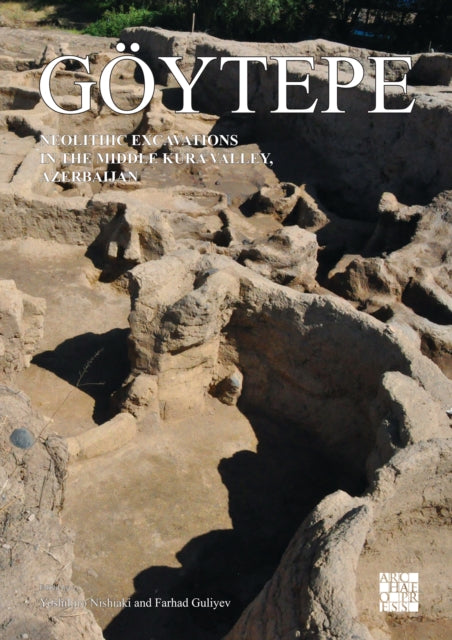Yoshihiro Nishiaki,Farhad Guliyev
Goeytepe: Neolithic Excavations in the Middle Kura Valley, Azerbaijan
Goeytepe: Neolithic Excavations in the Middle Kura Valley, Azerbaijan
YOU SAVE £4.22
- Condition: Brand new
- UK Delivery times: Usually arrives within 2 - 3 working days
- UK Shipping: Fee starts at £2.39. Subject to product weight & dimension
Bulk ordering. Want 15 or more copies? Get a personalised quote and bigger discounts. Learn more about bulk orders.
Couldn't load pickup availability
- More about Goeytepe: Neolithic Excavations in the Middle Kura Valley, Azerbaijan
The first phase of a joint Azerbaijan-Japan research program to investigate Göytepe, one of the largest known Neolithic mounds in the South Caucasus, has produced rich archaeological data from multi-disciplinary perspectives. This volume presents these details in a single report of the South Caucasian Neolithic site using a high-resolution chronology based on dozens of radiocarbon dates.
\n Format: Hardback
\n Length: 384 pages
\n Publication date: 11 February 2021
\n Publisher: Archaeopress
\n
Göytepe, located in the Middle Kura Valley of Azerbaijan, has been the focus of extensive Neolithic excavations from 2008 to 2013. These excavations have shed light on the emergence and development of food-producing communities in the South Caucasus, a region with a rich history of Neolithisation processes. Situated near the Fertile Crescent of Southwest Asia, where Neolithisation took place earlier, research in the South Caucasus raises intriguing questions regarding diffusion from the latter and interaction with 'incoming Neolithic communities, as well as the possibility of independent local Neolithisation processes. To address these issues, a joint research programme between Azerbaijan and Japan was launched in 2008 to investigate Göytepe, one of the largest known Neolithic mounds in the South Caucasus.
The results of the first phase of the project, which are presented in this volume, provide a wealth of archaeological data from various multidisciplinary perspectives. These include chronology, architecture, technology, social organisation, and plant and animal exploitation. This is the first time that these details have been presented in a single report on the South Caucasian Neolithic site, utilising a high-resolution chronology based on dozens of radiocarbon dates.
Göytepe's location in the Middle Kura Valley, close to the border with Iran, provides a unique setting for the study of Neolithic communities. The site is situated on a hilltop, overlooking the Kura River and its fertile floodplains. The excavations have revealed a complex network of settlements, with evidence of agricultural practices, such as crop cultivation and animal husbandry, dating back to the Neolithic period.
The architecture of the settlements at Göytepe is particularly noteworthy. The excavations have uncovered a series of circular and rectangular buildings, some of which were constructed using stone and mud brick. These buildings were designed to accommodate large groups of people, and they featured intricate architectural features, such as hearths and ovens, that were used for cooking and heating.
The technology used by the Neolithic communities at Göytepe was also advanced for its time. The excavations have revealed the use of stone tools, such as axes and chisels, as well as pottery and other ceramic artefacts. These technologies were used for a variety of purposes, including food preparation, tool making, and storage.
The social organisation of the Neolithic communities at Göytepe was complex and hierarchical. The excavations have revealed evidence of a complex system of social stratification, with different groups of people having access to different resources and privileges. There was also evidence of social mobility, with individuals rising to positions of power and influence within the community.
The plant and animal exploitation at Göytepe was also significant. The excavations have revealed the use of a variety of plants, including cereals, legumes, and fruits, for food production. The site also features evidence of animal husbandry, with the domestication of animals such as goats, sheep, and cattle.
In conclusion, Göytepe's Neolithic excavations have provided valuable insights into the emergence and development of food-producing communities in the South Caucasus. The site's location, architecture, technology, social organisation, and plant and animal exploitation have shed light on the complex processes that shaped the region's history and culture. The results of the first phase of the project have laid the foundation for further research and exploration of this important Neolithic site.
\n Weight: 1640g\n
Dimension: 216 x 303 x 29 (mm)\n
ISBN-13: 9781789698787\n \n
This item can be found in:
UK and International shipping information
UK and International shipping information
UK Delivery and returns information:
- Delivery within 2 - 3 days when ordering in the UK.
- Shipping fee for UK customers from £2.39. Fully tracked shipping service available.
- Returns policy: Return within 30 days of receipt for full refund.
International deliveries:
Shulph Ink now ships to Australia, Belgium, Canada, France, Germany, Ireland, Italy, India, Luxembourg Saudi Arabia, Singapore, Spain, Netherlands, New Zealand, United Arab Emirates, United States of America.
- Delivery times: within 5 - 10 days for international orders.
- Shipping fee: charges vary for overseas orders. Only tracked services are available for most international orders. Some countries have untracked shipping options.
- Customs charges: If ordering to addresses outside the United Kingdom, you may or may not incur additional customs and duties fees during local delivery.


